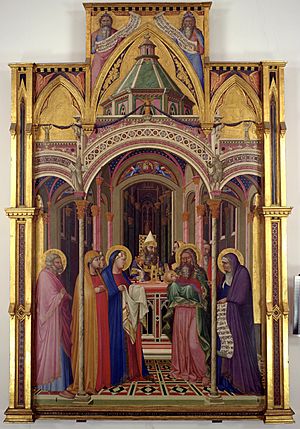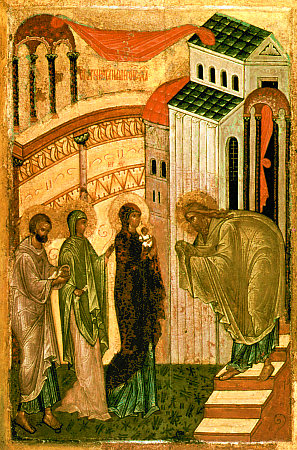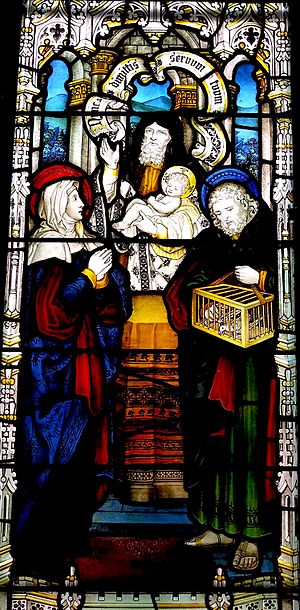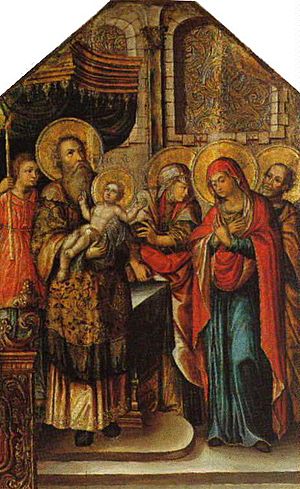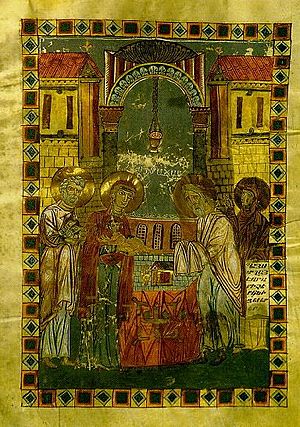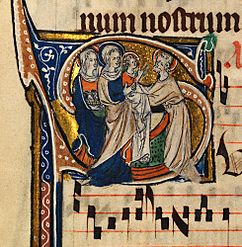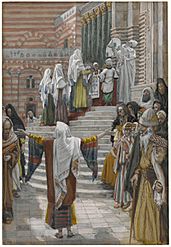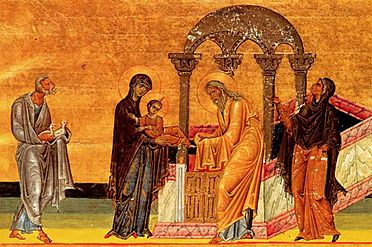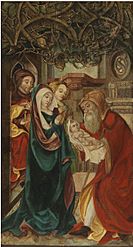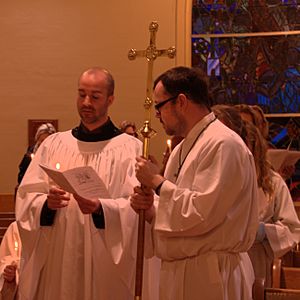Presentation of Jesus facts for kids
| Major events in Jesus's life in the Gospels |
|---|
|
The Presentation of Jesus is an important event in the early life of Jesus Christ. It describes when Jesus was brought to the Temple in Jerusalem. Many churches celebrate this event 40 days after Christmas. This day is often called Candlemas, or the "Feast of the Presentation of Jesus."
The story of the Presentation is found in chapter 2 of the Gospel of Luke in the New Testament. In this story, the Gospel of Luke combines two important Jewish traditions. These are the purification rite for mothers and the ceremony for the redemption of the firstborn son.
In the Eastern Orthodox Church, the Presentation of Jesus at the Temple is one of the twelve Great Feasts. It is sometimes called Hypapante, which means "meeting" in Greek. Orthodox Churches using the Julian Calendar celebrate it on February 15. The Armenian Church celebrates it on February 14.
In Western Christianity, this day is also known as the Feast of the Presentation of the Lord. Other older names include the Feast of the Purification of the Virgin or the Meeting of the Lord. For some churches, this feast marks the end of the Epiphany season. The Roman Catholic Church celebrates the Feast of the Presentation on February 2.
Contents
What the Bible Says about Jesus' Presentation
The story of Jesus' presentation is told in the Gospel of Luke (Luke 2:22–40). According to the Bible, Mary and Joseph took the Infant Jesus to the Temple in Jerusalem. This happened forty days after Jesus was born.
They went to the Temple for two main reasons. First, Mary needed to complete her ritual purification after childbirth. Second, they needed to perform the redemption of the firstborn son. These were both traditions from the Torah (Leviticus 12, Exodus 13:12–15).
Luke's Gospel mentions that Joseph and Mary were not wealthy. They offered "a pair of turtledoves, or two young pigeons." This was the offering allowed for poorer families (Leviticus 12:8). The purification ceremony for a male child was to take place forty days after birth (Leviticus 12:1–4). This is why the Presentation is celebrated forty days after Christmas.
Simeon and Anna Meet Jesus
When Mary and Joseph brought Jesus to the Temple, they met an old man named Simeon. The Bible says that Simeon had been promised he would not die until he had seen the Lord's Christ (Luke 2:26).
Simeon took Jesus in his arms and praised God. He then spoke a prophecy to Mary. He said, "Behold, this child is set for the fall and rising of many in Israel." He also said, "a sword will pierce through your own soul also" (Luke 2:34–35). This meant Mary would experience great sorrow.
An elderly prophetess named Anna was also at the Temple. She gave thanks to God for Jesus. She spoke about Jesus to everyone who was looking for redemption in Jerusalem (Luke 2:36–38).
How the Presentation of Jesus is Celebrated
| The Presentation of Jesus at the Temple | |
|---|---|

Presentation of Christ at the Temple by Hans Holbein the Elder, 1500–01 (Kunsthalle Hamburg)
|
|
| Observed by | |
| Type | Christian |
| Date | 2 February (Gregorian) 14 February (Armenian Apostolic Church) |
Names for the Celebration
This celebration has several names. It is known as the Feast of the Presentation of Jesus at the Temple. Other names include Candlemas, the Feast of the Purification of the Virgin, and the Meeting of the Lord.
The date of Candlemas is always 40 days after Christmas. This is because, under Mosaic law, a mother who had a baby boy was considered unclean for a certain period. Mary's purification ceremony would have taken place 40 days after Jesus' birth (Leviticus 12:2–8). The Gospel of Luke (2:22–39) explains that Mary followed this law.
In the Roman Catholic Church, it is now called the Presentation of the Lord. In the Eastern Orthodox Church, it is known as the Feast of the Presentation of our Lord, God, and Savior Jesus Christ in the Temple. It is also called The Meeting of Our Lord, God and Saviour Jesus Christ.
Many churches in the Anglican Communion also celebrate this day. They use names like The Presentation of Our Lord Jesus Christ in The Temple (Candlemas) or The Presentation of Christ in the Temple.
The name Candlemas is common in northern Europe. It comes from the tradition of having a procession with lighted candles during the church service on this day. This tradition reminds people of Simeon's words about Jesus being "a light for revelation to the Gentiles."
Traditions and Practices
Candlemas was traditionally the last feast day in the Christian year that was connected to Christmas. It is seen as another "epiphany" type feast. This means it is a day when Jesus is revealed as the Messiah.
Western Christian Traditions
Candlemas happens 40 days after Christmas. In Western Christianity, it was traditional for a priest to bless beeswax candles on February 2. These candles would then be used throughout the year. Some were given to people to use in their homes.
In Poland, this feast is called Święto Matki Bożej Gromnicznej. This means "Feast of Our Lady of Thunder candles." The blessed candles, called gromnice, are lit during thunderstorms. They are placed in windows to protect homes from storms.
In the Roman Catholic Church, the focus has shifted. It is now called the Feast of Presentation of the Lord. The emphasis is more on Simeon the Righteous's prophecy. The blessing of candles and Mary's purification are still part of it but less emphasized. Pope John Paul II also connected this day to the renewal of religious vows. The Presentation of Jesus in the Temple is the fourth Joyful Mystery of the Rosary.
Eastern Christian Traditions
In the Byzantine tradition of the Eastern Orthodox Church, the Meeting of the Lord is a very special feast. It combines elements of a Great Feast for the Lord and a Great Feast for the Theotokos (Mother of God). It has a short period of preparation before the feast and a longer celebration period after.
The holiday begins with an all-night vigil the evening before. The main celebration is the Divine Liturgy the next morning. During this service, beeswax candles are blessed. The priest reads prayers and blesses the candles with holy water. The candles are then given to the people, and the Liturgy begins.
Because of the events in Luke's Gospel, the practice of the Churching of Women became common. This is a blessing for mothers after childbirth. While it has mostly faded in Western churches, it is still practiced in the Orthodox Church. Also, babies are often brought to church on their fortieth day after birth. This remembers Mary and Joseph bringing Jesus to the Temple.
Some Christians choose to keep their Christmas decorations up until Candlemas.
When is the Presentation of Jesus Celebrated?
In both Eastern and Western liturgical calendars, the Presentation of the Lord is on February 2. This is exactly forty days after Christmas. In the Church of England, it can be celebrated on February 2 or on the Sunday between January 28 and February 3. This feast never falls during Lent.
In Swedish and Finnish Lutheran Churches, Candlemas is always celebrated on a Sunday. It can be as early as February 2 and as late as February 8.
The Armenian Apostolic Church celebrates this feast, called "The Coming of the Son of God into the Temple" (Tiarn'ndaraj), on February 14. This is because Armenians celebrate Christmas on January 6. So, their feast is also 40 days after their Christmas. The night before the feast, Armenians light candles during a church service. They carry the flame outside or light a bonfire in the churchyard. This symbolizes bringing light into the darkness.
History of the Feast
The Feast of the Presentation is one of the oldest feasts in the Christian Church. It has been celebrated since the fourth century in Jerusalem. Many early church leaders, like Cyril of Jerusalem and John Chrysostom, gave sermons about this feast.
An early pilgrim named Egeria wrote about her travels to the Holy Land (381–384). She reported that February 14 was a special day in Jerusalem. There was a procession to the Basilica of the Resurrection. A homily (sermon) was given about Luke 2:22, making the reason for the celebration clear. This shows that in Jerusalem at that time, Christ's birth was celebrated on January 6, the Epiphany.
Around AD 450 in Jerusalem, people started the custom of holding lighted candles during the church service on this day. At first, it was a smaller celebration. But in 541, a terrible plague hit Constantinople, killing thousands. The Emperor Justinian I ordered a time of fasting and prayer. On the Feast of the Meeting of the Lord, large processions were held. A special prayer service was done to ask for an end to the plague, and it stopped. In thanks, the feast was made a more important celebration in 542.
In Rome, the feast appeared in the Gelasian Sacramentary around the seventh or eighth century. Here, it was first called the Feast of Purification of the Blessed Virgin Mary. The date in Rome was February 2 because Christmas had been celebrated on December 25 since at least the early fourth century.
Candlemas became important in the secular (non-religious) calendar too. It was a traditional day for farmers to move cattle from hay meadows. It was also a day for paying debts and hiring servants in Scotland and parts of northern England.
How it Relates to Other Celebrations
The Feast of the Presentation's date depends on Christmas. As the Gospel of Luke (Luke 2:22–40) describes, the celebration is 40 days after Jesus' birth. The blessing of candles on this day reminds us of Simeon calling baby Jesus the "light for revelation to the Gentiles" (Luke 2:32).
Some modern Pagans believe that Candlemas is a Christianization of the Gaelic festival of Imbolc. Imbolc was celebrated in pre-Christian Europe around the same time of year. Imbolc is also called "St. Brigid's Day" in Ireland. Both the goddess Brigid and the Christian Saint Brigid are linked to sacred flames, healing, and smithcraft. However, historians generally agree that the Christian feast developed independently.
In Irish homes, there were many traditions for welcoming Brigid into the home. Some of these traditions later became connected to Saint Brigid. In Ireland and Scotland, she is sometimes called the "foster mother of Jesus."
In Armenia, celebrations at the Presentation have been influenced by older customs. These include farmers spreading ashes for a better harvest. Also, young men might leap over a bonfire.
The tradition of lighting a candle in each window is not the reason for the name "Candlemas." The name comes from the blessing of candles in church.
The day after Candlemas, the feast of St. Blaise is celebrated. This is connected to the rite of the Blessing of the Throats. This blessing is often given with crossed candles.
The Presentation of Jesus in Art
The event of Jesus' Presentation is often shown in art. It is a common part of large art series about the Life of Christ and the Life of the Virgin. Early artworks focused on the moment Simeon met Jesus.
In Western art, starting around the 8th or 9th century, artists began to show Simeon wearing the special clothes of a Jewish High Priest. He is often shown performing a ceremony at an altar, surrounded by Mary, Joseph, and Anna. In Western art, Simeon is usually holding Jesus or is about to receive him. In Eastern art, Mary is more likely to still be holding Jesus. In Eastern Churches, this event is called the Hypapante.
Simeon's words to Mary, "you yourself a sword will pierce," led to art showing the Sorrowful Mother.
Gallery of Artworks
-
Presentation of Jesus at the Temple, 12th century cloisonné enamel icon from Georgia
-
James Tissot, The Presentation of Jesus in the Temple (La présentation de Jésus au Temple), Brooklyn Museum
-
Presentation of Christ in the Temple, South German, likely altarpiece wing, late 15th century. (Private collection)
The Presentation of Jesus in Music
Many songs and anthems have been written to celebrate this feast. They are often performed during church services. For example, the 16th-century German composer Johannes Eccard wrote "Maria wallt zum Heiligtum."
The Lutheran church during the Baroque period observed the feast as Mariae Reinigung (Purification of Mary). Johann Sebastian Bach composed several cantatas for this day's church service. These often related to Simeon's canticle Nunc dimittis.
- Erfreute Zeit im neuen Bunde, BWV 83, 1724
- Mit Fried und Freud ich fahr dahin, BWV 125, 1725
- Ich habe genug, BWV 82, 1727
Traditions and Superstitions
According to a poem by Robert Herrick, the evening before Candlemas was the day to remove Christmas decorations. People believed that leaving greenery up would bring bad luck.
In Scotland, Candlemas was one of the traditional quarter days. On these days, quarterly rents were due, and other business deals happened.
In the United Kingdom, good weather on Candlemas Day is thought to mean more winter weather is coming. A saying goes: "If Candlemas Day is clear and bright, / winter will have another bite. / If Candlemas Day brings cloud and rain, / winter is gone and will not come again." It is also believed that bears and wolves emerge from hibernation on this day to check the weather. If they go back to their dens, it means winter will continue. This belief is similar in Italy, where it's called Candelora.
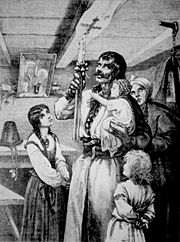
In the United States, Candlemas happens on the same day as Groundhog Day. This American tradition also involves predicting the weather based on an animal's behavior.
In France and Belgium, Candlemas (French: La Chandeleur) is celebrated by eating crêpes. In Italy, it is traditionally seen as the last cold day of winter.
In Southern and Central Mexico, and Guatemala City, Candlemas (Spanish: Día de La Candelaria) is celebrated with tamales. On the night before Three Kings Day, whoever finds a small doll inside the Rosca de Reyes must pay for the tamales and host a party on Candlemas. In some parts of Mexico, families dress up their baby Jesus figures from their nativity scenes.
In Luxembourg, on Liichtmëss, children carry lighted sticks. They visit neighbors and sing a traditional song in exchange for sweets.
Sailors were often hesitant to start a voyage on Candlemas Day. They believed it would end in disaster. This might be because February often has severe storms.
For over eight centuries, the swaddling clothes that baby Jesus wore during the presentation are said to be kept in Dubrovnik Cathedral, Croatia.
See also
 In Spanish: Presentación de Jesús en el Templo para niños
In Spanish: Presentación de Jesús en el Templo para niños
- "A Song for Simeon", a 1928 poem by T.S. Eliot
- Lupercalia
- Our Lady of Sorrows
- Presentation of Mary
- Category:Paintings of the Presentation of Christ at the Temple


